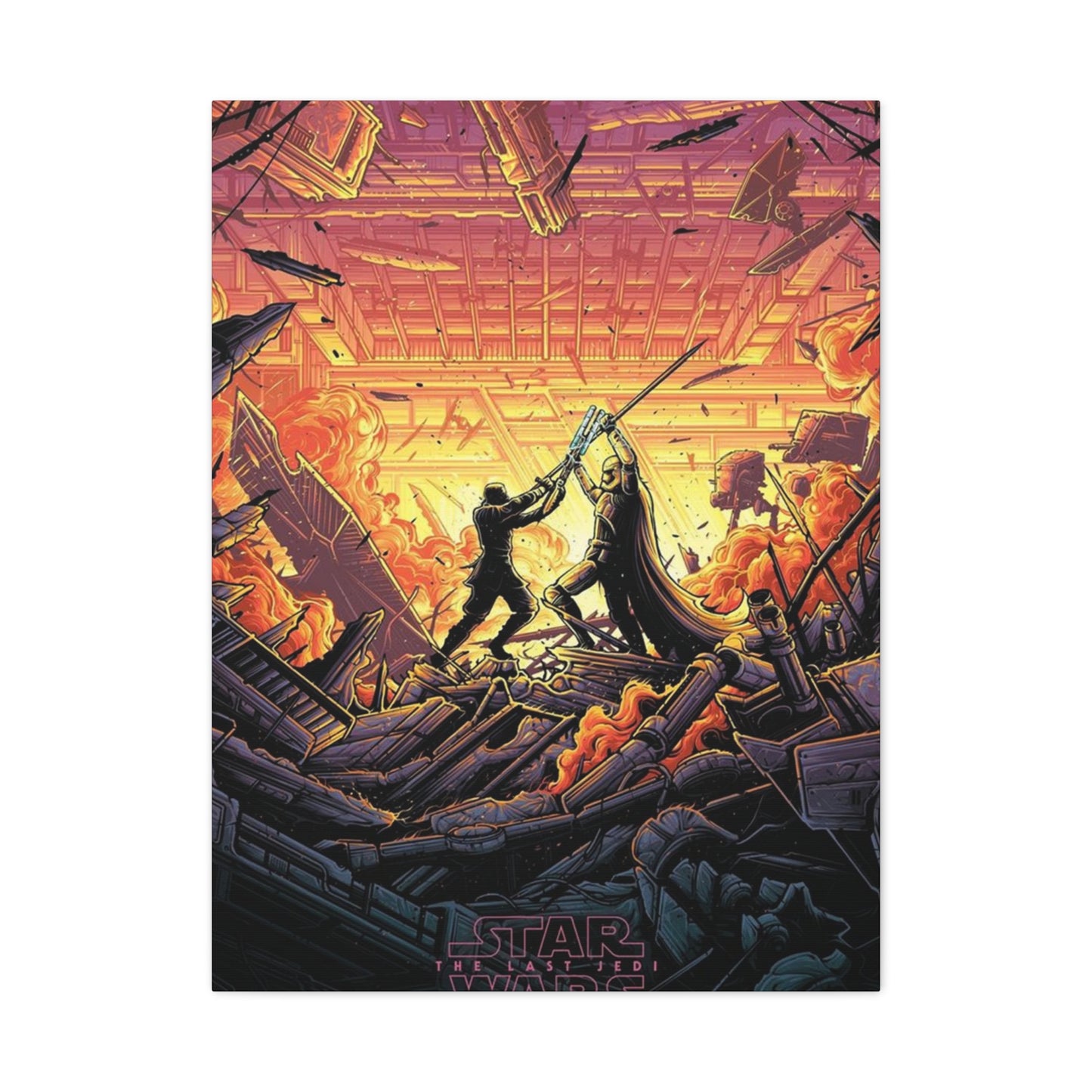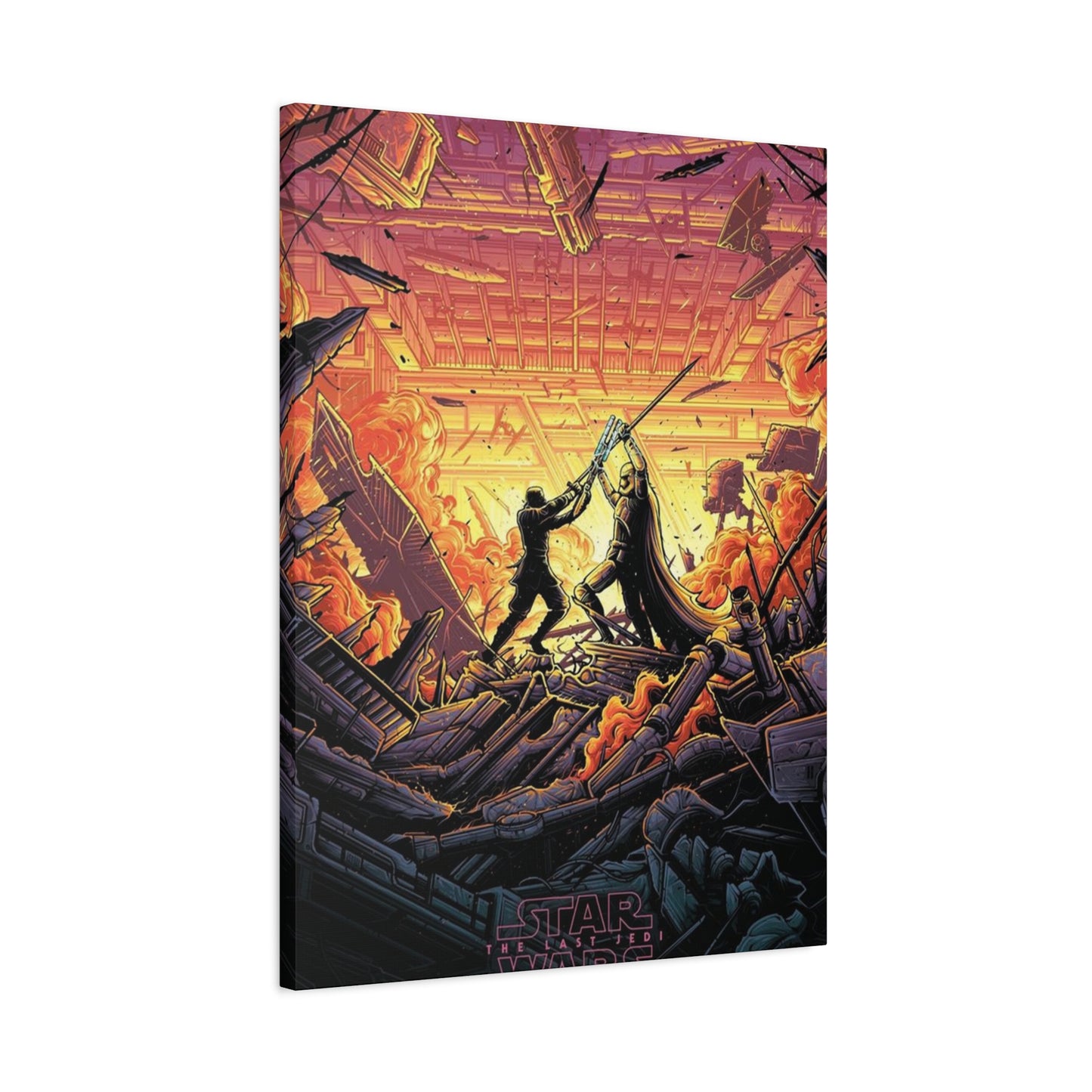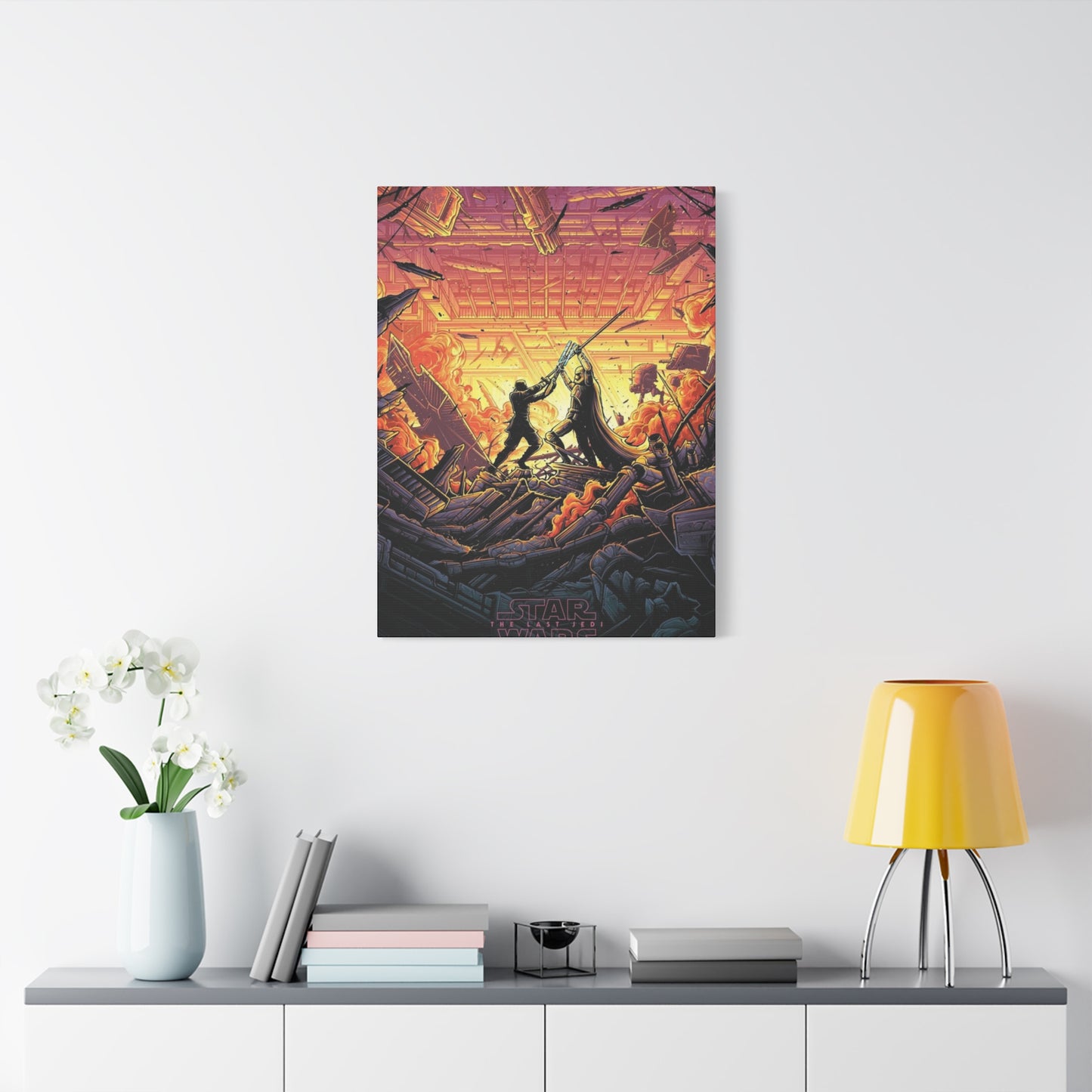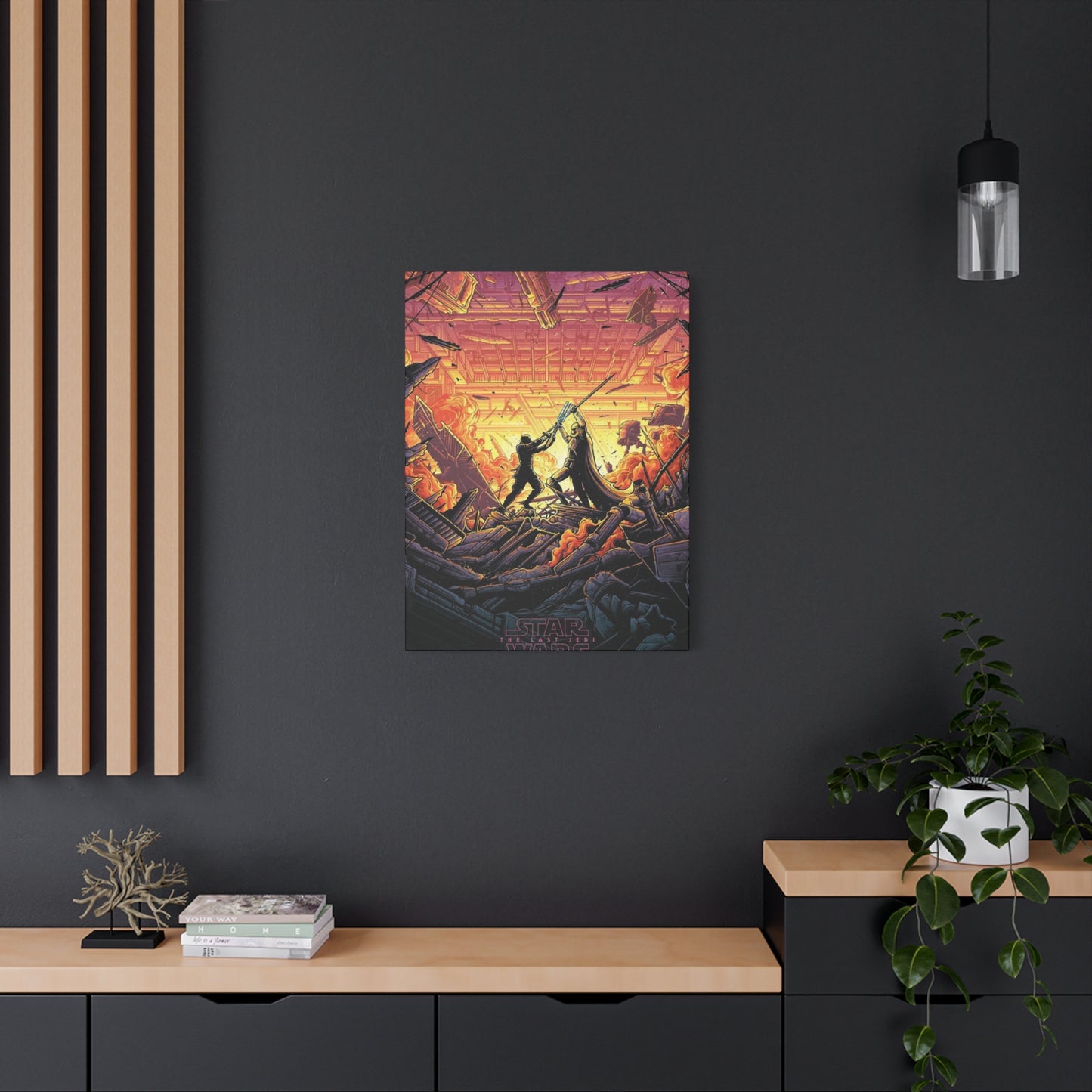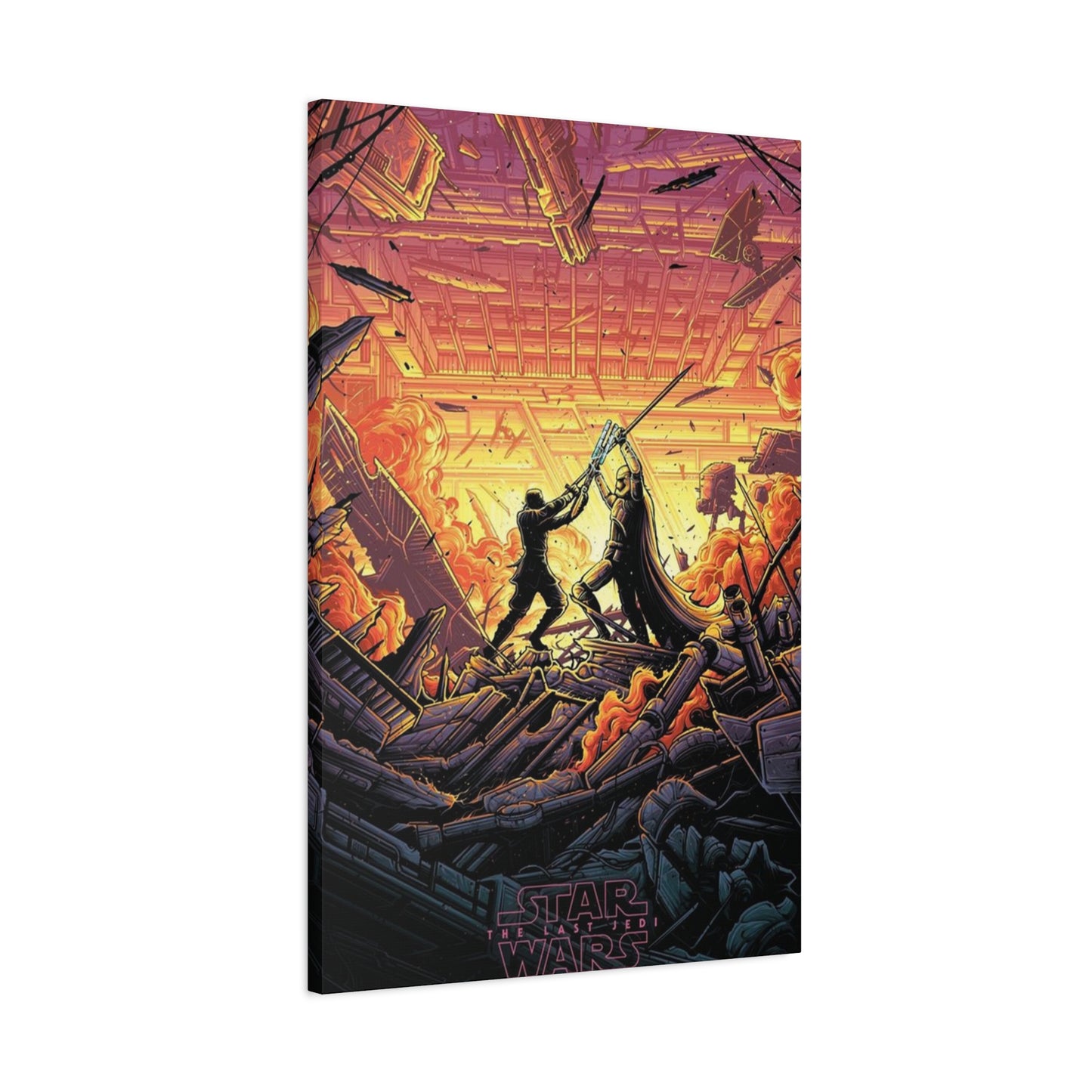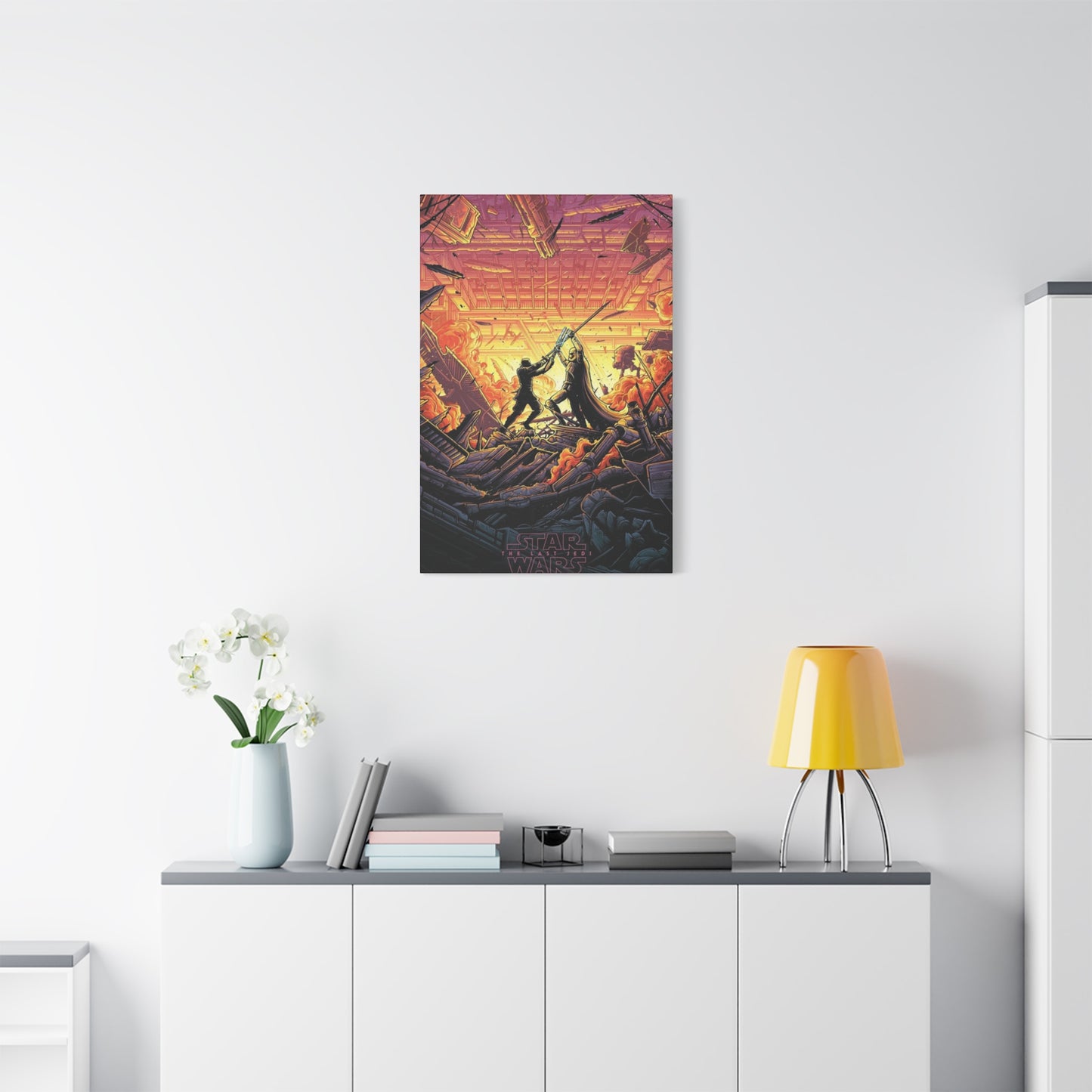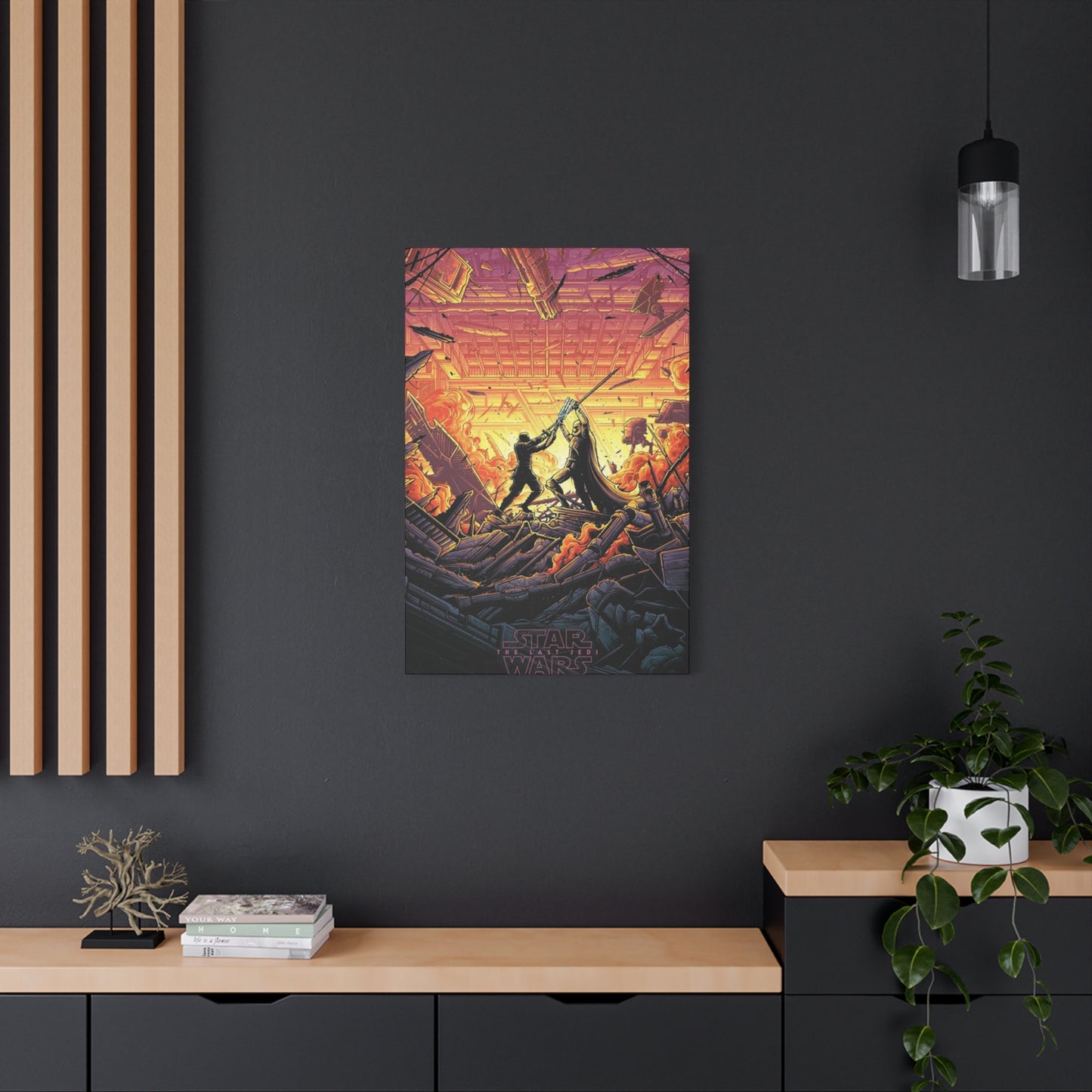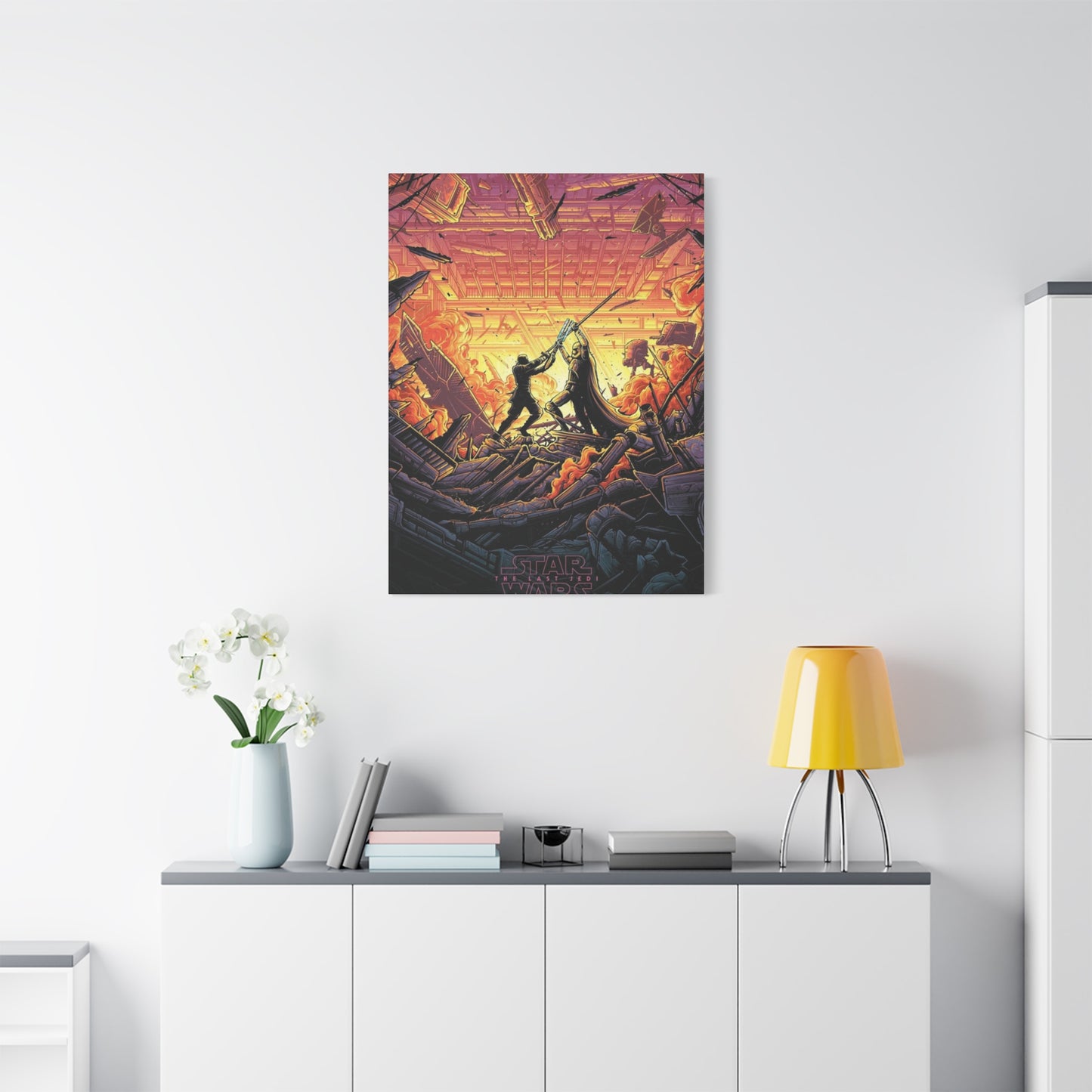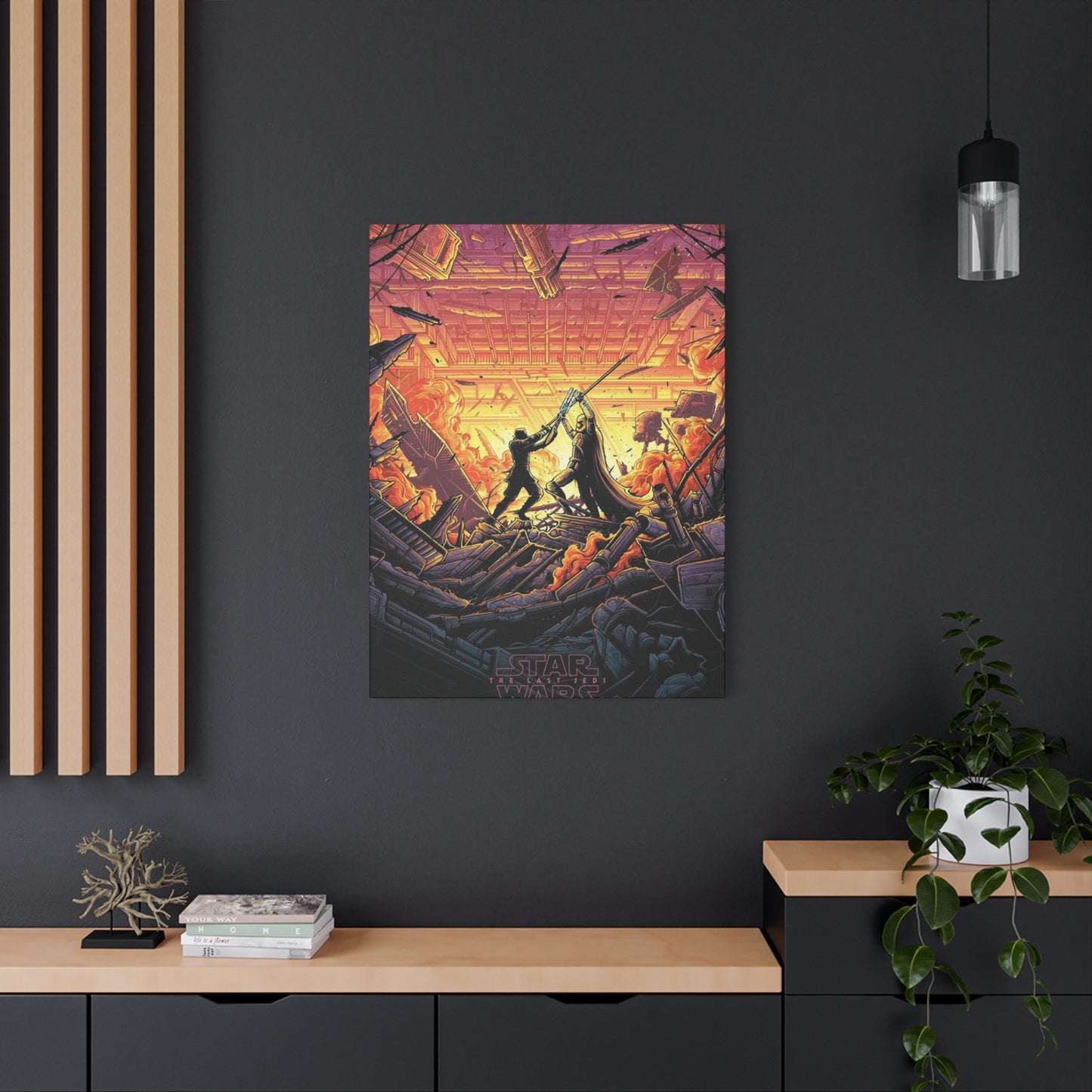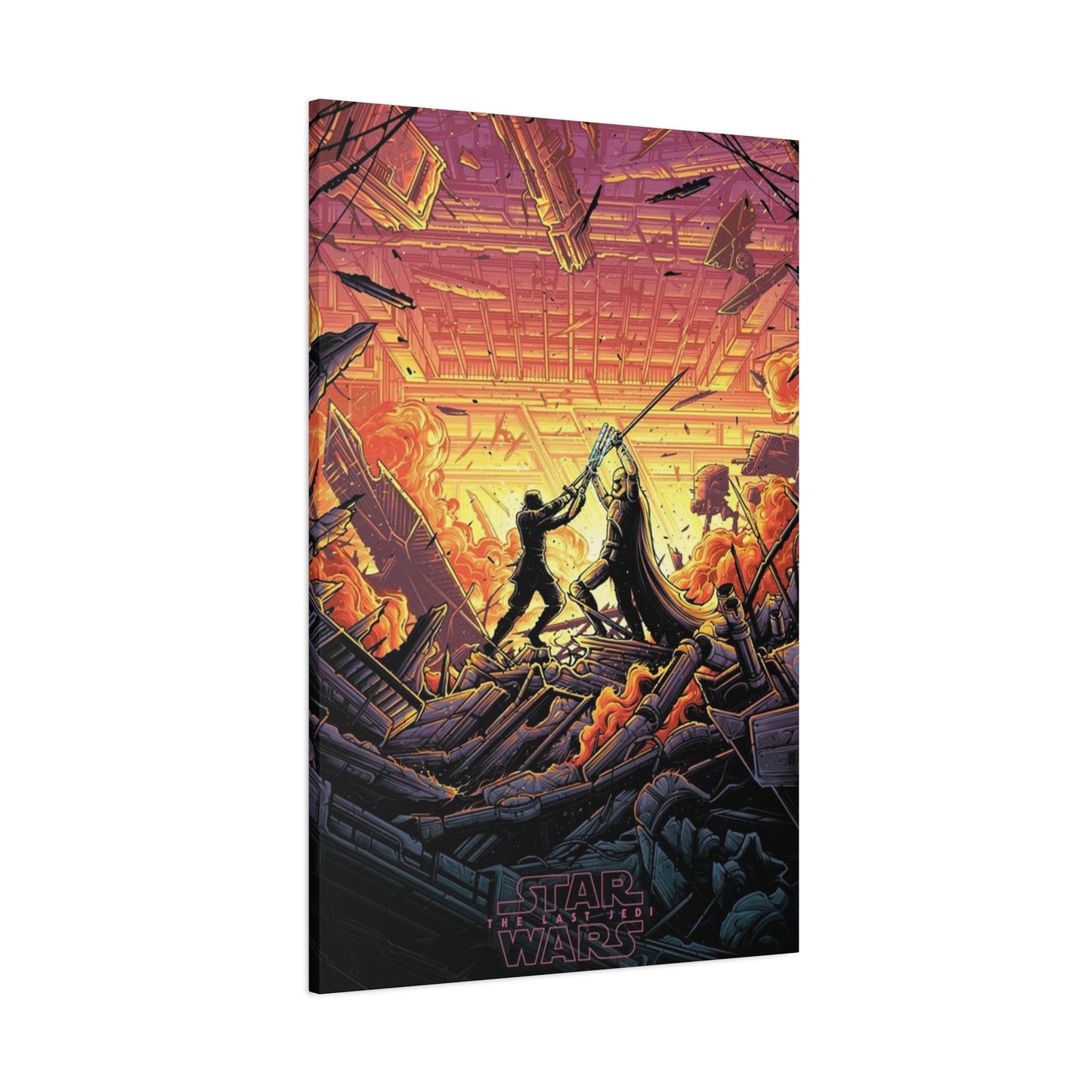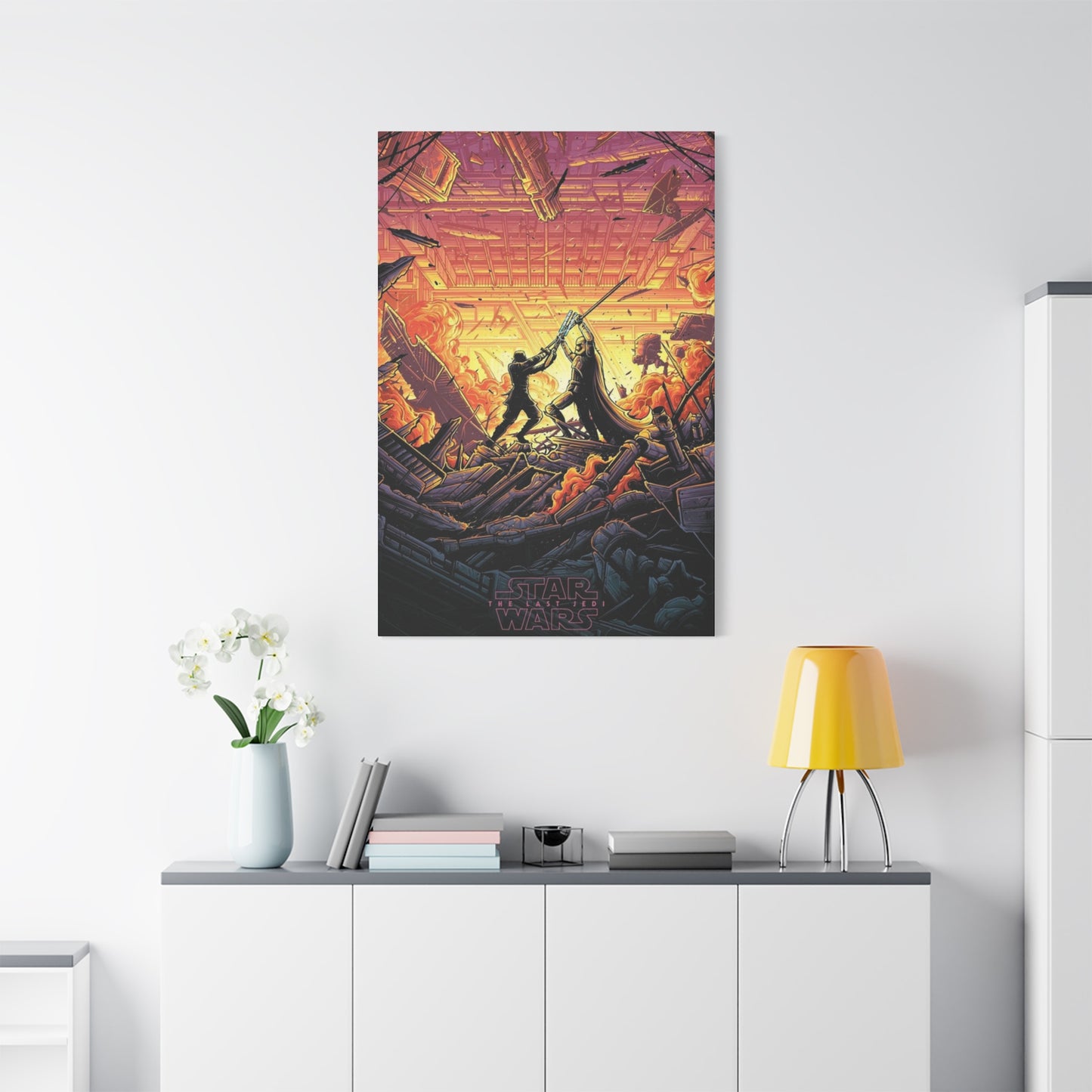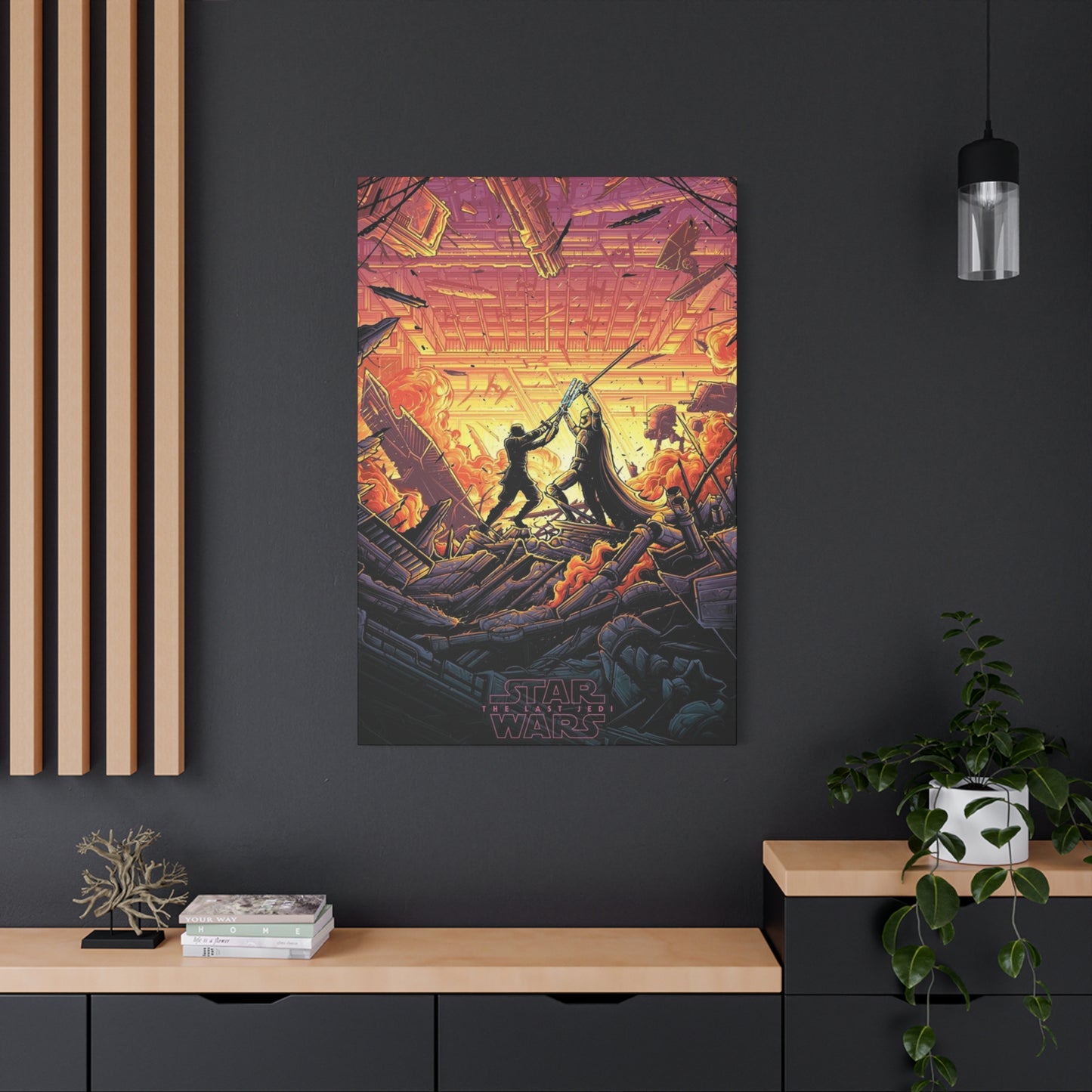Epic Jedi Combat: Add Action and Adventure with Jedi Fighting Poster Wall Art
The world of Star Wars has always been defined by its ability to merge storytelling with striking visual representation. Among the countless pieces of artwork that have emerged from this beloved franchise, one particular piece stands out for its emotional depth and artistic excellence. The poster featuring the climactic confrontation between two of the saga's most compelling characters has become a symbol of modern Star Wars fandom, representing not just a moment in cinematic history but an entire philosophy about conflict, redemption, and the choices that define us.
This artwork has transcended its original purpose as promotional material to become a cultural artifact in its own right. Fans across the globe have embraced this visual representation of one of the most emotionally charged sequences in recent Star Wars cinema. The imagery captures a pivotal moment that resonates with audiences on multiple levels, offering both aesthetic pleasure and deeper thematic significance. Through careful composition, color theory, and symbolic representation, this piece has earned its place as one of the most recognizable and beloved artworks in the franchise's extensive visual library.
The significance of this poster extends far beyond its immediate visual appeal. It represents a turning point in how Star Wars art is conceived, created, and consumed by its passionate fanbase. The design choices made in creating this piece reflect a deep understanding of what makes Star Wars resonate with audiences across generations. From the careful balance of light and shadow to the dynamic positioning of the characters, every element works in harmony to create a piece that is both instantly recognizable and endlessly fascinating.
The Influence of Star Wars Artwork on Popular Culture
Star Wars has fundamentally changed how we think about film merchandising and promotional artwork. From the very beginning, the franchise understood that visual art could be just as important as the films themselves in building a lasting cultural legacy. The poster featuring the red-hued battleground confrontation continues this tradition while pushing it into new territory. This particular piece has influenced not just how Star Wars markets itself, but how the entire entertainment industry thinks about promotional artwork and fan engagement.
The artwork draws from a rich tradition of movie poster design that dates back to the earliest days of cinema. However, it also incorporates modern sensibilities and design philosophies that speak to contemporary audiences. The minimalist approach combined with bold color choices creates an immediately recognizable silhouette that can be understood at a glance, yet rewards closer inspection with layers of detail and meaning. This balance between immediate impact and deeper complexity is what sets truly great artwork apart from merely competent design.
Film promotion has evolved dramatically since the original Star Wars trilogy first captured imaginations in the late 1970s. Today's audiences are more visually sophisticated and have access to an unprecedented amount of content. In this environment, promotional artwork needs to work harder than ever to cut through the noise and make an impression. The fighting poster achieves this by focusing on a single, emotionally resonant moment rather than trying to cram every character and plot point into one image. This restraint paradoxically makes the artwork more powerful and memorable.
The cultural impact of this poster can be measured in multiple ways. It has been reproduced countless times on various media, from traditional wall hangings to digital wallpapers, from t-shirts to coffee mugs. Each reproduction spreads the image further, embedding it deeper into popular consciousness. Young fans who may not have seen the film in theaters still recognize the imagery, demonstrating its power to transcend its original context and become a symbol of the franchise itself.
Beyond commercial success, this artwork has inspired countless fan artists to create their own interpretations and variations. Online communities dedicated to Star Wars art regularly feature pieces that pay homage to or reinterpret the original design. This creative dialogue between official artwork and fan creation enriches the entire Star Wars artistic ecosystem, creating a vibrant culture of visual expression that keeps the franchise feeling fresh and relevant even decades after its inception.
Character Confrontation Depicted in Poster Design
The central conflict portrayed in this artwork represents one of the most complex relationships in modern Star Wars storytelling. The two figures locked in combat are not simple heroes and villains but characters with deep connections, shared history, and parallel journeys. This complexity is reflected in every aspect of the poster's design, from the positioning of the figures to the color palette that surrounds them. The artwork doesn't present a simple good versus evil narrative but instead captures the ambiguity and emotional turmoil that defines their relationship.
Rey's journey from scavenger to hero is one of the most compelling character arcs in recent Star Wars cinema. Her stance in the poster reflects her determination and growing confidence, yet there's also a sense of vulnerability that makes her relatable. The way she's positioned suggests both offensive action and defensive necessity, capturing the duality of her situation. She's fighting not just against an external enemy but also against the pull of darkness within herself, a struggle that gives her character depth and makes her journey emotionally resonant.
Kylo Ren represents a different kind of conflict, one rooted in family legacy and the weight of expectations. His presence in the poster is commanding yet tortured, reflecting the internal struggle that defines his character. The design choices emphasize his imposing nature while also hinting at his vulnerability. This balance makes him one of the most interesting antagonists in Star Wars history, neither purely evil nor simply misunderstood but something more nuanced and human. His confrontation with Rey is as much about his own internal demons as it is about actual physical combat.
The dynamic between these characters is what makes this artwork so compelling. They're mirror images in many ways, both struggling with their identities and their places in the larger cosmic struggle between light and darkness. The poster captures this mirroring through careful symmetry in the composition, while the differences in their postures and the subtle variations in how they're lit speak to their divergent paths. This visual storytelling conveys complex narrative information without a single word, demonstrating the power of well-executed design.
The weapons they wield carry their own symbolic weight within the Star Wars universe. Lightsabers have always represented more than simple tools of combat; they're extensions of their wielders' personalities and beliefs. The way these weapons are depicted in the poster, crossing against the crimson background, creates a visual focal point that draws the eye and emphasizes the intensity of their conflict. The energy and motion implied by their positioning suggests a battle that is as much spiritual as physical, a clash not just of bodies but of philosophies and destinies.
The emotional subtext of this confrontation adds layers of meaning to the artwork. These characters share a connection that transcends simple enmity. There's a tension between attraction and repulsion, understanding and conflict, hope and despair. The poster captures all of these contradictions in a single frozen moment, creating an image that fans can return to repeatedly and find new meaning in each viewing. This depth is what transforms a simple promotional poster into a genuine work of art that stands on its own merits.
Popular Reception Among Star Wars Enthusiasts
The Star Wars fandom is known for its passionate engagement with all aspects of the franchise, and this artwork has proven to be no exception. From the moment it was first revealed, fans recognized that they were seeing something special. The response across social media platforms was overwhelmingly positive, with countless fans sharing their enthusiasm and analyzing every detail of the composition. This immediate and sustained positive reception helped cement the poster's status as a modern classic within the franchise.
Fan communities dedicated to collecting Star Wars memorabilia have embraced this poster as an essential piece for any serious collection. Discussion forums and social media groups regularly feature posts showing different versions of the artwork, from officially licensed prints to fan-made variations. The poster has become a common sight in photographs of fan rooms and home theaters, serving as a centerpiece that declares the owner's allegiance to this particular era of Star Wars storytelling. This widespread adoption by serious collectors speaks to the artwork's quality and cultural significance.
The poster's popularity extends beyond hardcore collectors to more casual fans as well. Its striking visual design makes it appealing even to those who may not follow every detail of Star Wars lore or own extensive collections of memorabilia. This broad appeal is partly due to the artwork's aesthetic qualities, which work independently of deep franchise knowledge. Someone unfamiliar with the specific characters or their story can still appreciate the bold composition, dramatic color scheme, and dynamic energy of the piece. This accessibility helps explain why it has become such a ubiquitous presence in pop culture.
Online retailers have reported strong and consistent sales of prints featuring this design, with certain variations becoming particularly sought after. Limited edition releases often sell out quickly, and the secondary market for rare prints can see prices significantly exceed the original retail value. This economic reality reflects genuine demand driven by the artwork's popularity rather than artificial scarcity. Fans want this image on their walls, and they're willing to pay premium prices for high-quality reproductions that do justice to the original design.
The artwork has also inspired cosplayers and fan filmmakers, who recreate the scene depicted in the poster for their own creative projects. Convention floors regularly feature photo opportunities where fans can pose in front of reproductions of the distinctive red-salt background, recreating the iconic confrontation for themselves. This participatory element adds another dimension to the poster's cultural impact, transforming viewers into active participants who engage with the artwork through their own creative expression.
Critics and art analysts have also weighed in on the poster's merits, generally offering positive assessments of its design and execution. Professional designers have praised the bold color choices and effective use of negative space, while film scholars have noted how effectively the image encapsulates the themes and conflicts central to the film's narrative. This recognition from both fan communities and professional critics validates the artwork's quality and ensures its place in discussions of great movie poster design.
Decorating Your Living Space with Star Wars Memorabilia
Incorporating beloved franchise artwork into home decor requires thoughtful consideration of multiple factors. The poster featuring the dramatic red-background confrontation offers numerous possibilities for enhancing living spaces while celebrating fandom. The key to successful integration lies in understanding how the artwork's visual properties interact with existing design elements in a room. The bold red color scheme, while striking, needs to be balanced carefully against other colors and textures to create a harmonious overall aesthetic rather than an overwhelming focal point.
Living rooms present excellent opportunities for displaying this type of artwork, particularly in spaces dedicated to entertainment. Many fans choose to create dedicated media rooms or home theaters where Star Wars memorabilia takes center stage. In these contexts, the poster can be displayed prominently without concern about clashing with other design elements, as the entire space is themed around the franchise. Large format prints work especially well in these settings, where they can be viewed from comfortable seating distances and appreciated in their full glory.
Bedroom spaces offer more intimate settings for this artwork, where its dramatic imagery can inspire and energize. Young fans particularly appreciate having heroic characters watching over their personal spaces, creating environments that reflect their interests and passions. For adults, the poster can serve as a reminder of beloved stories and characters, adding personality to what might otherwise be generic bedroom decor. The key is selecting an appropriate size that enhances rather than dominates the space, creating visual interest without overwhelming the room's primary function as a restful retreat.
Home offices and study spaces can benefit from the motivational qualities of this artwork. The depiction of characters engaged in struggle and conflict can serve as inspiration for perseverance and determination in one's own challenges. Many professionals who work from home find that surrounding themselves with images that hold personal meaning helps create a more engaging and personalized work environment. The poster's dramatic energy can help combat the monotony of long work sessions, serving as a visual break that refreshes the mind.
Basement recreation rooms and garage spaces offer less formal settings where larger, more dramatic displays become possible. These areas often serve as male-dominated spaces or family game rooms where bold artwork is not just accepted but celebrated. Here, the poster can be combined with other Star Wars memorabilia to create immersive themed environments. Multiple pieces featuring different characters or scenes from the same film can be arranged together to tell a larger visual story, with the fighting poster serving as a dramatic centerpiece that anchors the entire display.
Lighting plays a crucial role in how artwork is perceived and appreciated. The poster's bold red tones respond particularly well to proper illumination, which can enhance the drama and intensity of the image. Dedicated picture lights or strategically placed spot lighting can transform the viewing experience, bringing out details that might be missed under general room lighting. Some fans invest in adjustable lighting systems that allow them to change how the artwork appears depending on time of day or mood, creating different atmospheres within the same space.
The decision between framed and unframed displays affects both the artwork's appearance and its longevity. Quality framing protects the print from environmental damage while also elevating its presentation from simple poster to serious artwork. The choice of frame style should complement both the artwork itself and the surrounding decor. Modern minimalist frames work well with the poster's contemporary aesthetic, while more elaborate frames can add gravitas and make the piece feel more substantial. Matting decisions also impact the final appearance, with careful mat selection helping to enhance the artwork's colors and draw the viewer's eye to the most important compositional elements.
Value of Star Wars Collectibles
The market for Star Wars memorabilia has proven remarkably robust over decades, with certain items appreciating significantly in value. The fighting poster occupies an interesting position within this collector ecosystem, offering both immediate aesthetic satisfaction and potential long-term investment value. Understanding the factors that influence collectibility helps fans make informed decisions about their purchases, whether they're primarily motivated by love of the franchise or by investment considerations.
Condition is paramount in determining the value of any collectible, and posters present particular challenges in this regard. Paper-based items are vulnerable to numerous forms of degradation, from sunlight fading to moisture damage to simple wear and tear. Serious collectors invest in archival-quality materials for storage and display, using acid-free backing boards, UV-protective glazing, and climate-controlled environments to preserve their pieces. Items that have been professionally preserved and maintained in pristine condition command premium prices on the secondary market, often many times what poorly maintained examples might fetch.
Limited edition releases create artificial scarcity that can drive up values significantly. Official prints released in small quantities, particularly those numbered and signed by artists or actors, become highly sought after by collectors. The poster has been released in various limited editions over the years, each with its own distinct characteristics and collectibility factors. Early releases, first printings, and special variant editions tend to appreciate more than widely available standard prints, though all versions maintain baseline value due to the enduring popularity of the imagery.
Provenance and authenticity documentation add substantial value to collectible items. Official licenses, certificates of authenticity, and clear chains of custody help establish that a piece is genuine rather than an unauthorized reproduction. The proliferation of counterfeit merchandise in the Star Wars collecting space makes authentication increasingly important. Reputable dealers and auction houses provide documentation and verification services that give buyers confidence, but these services come at a cost that factors into overall investment considerations.
Market trends in Star Wars collecting follow broader patterns in nostalgia and popular culture. The release of new films or television series in the franchise typically triggers increased interest in related memorabilia, including posters from previous entries in the series. The poster has benefited from this cyclical interest, with values rising during periods of heightened franchise activity. Savvy collectors pay attention to these cycles, potentially timing purchases and sales to maximize returns.
The crossover appeal of this particular artwork extends beyond Star Wars collectors to general movie poster enthusiasts and modern art collectors. This broader market base provides additional support for values and creates multiple channels for buying and selling. Galleries that specialize in movie memorabilia regularly feature this poster, and it has appeared in museum exhibitions dedicated to film art. This elevation from simple merchandise to recognized artwork adds prestige and potentially increases long-term value.
Investment in collectibles should never be viewed in purely financial terms, however. The primary value for most fans lies in the joy of ownership and the connection to beloved stories and characters. The poster's ability to enhance living spaces and provide daily enjoyment represents a return that transcends monetary considerations. Even if market values remain stable or decline, the personal satisfaction derived from owning a quality representation of meaningful art justifies the investment for many collectors.
Diversification within a collection helps manage risk and maximize enjoyment. Rather than investing heavily in a single item, experienced collectors build varied portfolios that include different types of memorabilia from across the franchise's history. The fighting poster might be just one element in a broader collection that includes action figures, prop replicas, original production materials, and other artwork. This approach spreads risk while allowing collectors to engage with multiple aspects of what makes Star Wars culturally significant.
The Famous Lightsaber Battle Captured in Art
Lightsaber combat has been central to Star Wars' visual identity since the very first film introduced audiences to these elegant weapons. The duel depicted in this poster represents the culmination of evolving lightsaber choreography and cinematography techniques developed over decades of filmmaking. Unlike earlier, more stylized duels, this confrontation grounds its action in emotional authenticity, making every movement meaningful beyond simple spectacle. The poster captures a specific moment from this sequence, freezing the kinetic energy of combat into a single powerful image.
The choice to depict this particular moment rather than any other from the extended sequence reveals thoughtful curation by the poster's designers. The selected frame balances aesthetic considerations with narrative significance, showing both combatants in dynamic poses that convey motion and intensity. The crossed lightsabers create a natural focal point that draws the eye, while the positioning of the figures establishes the confrontational nature of their relationship. Every element works together to communicate the scene's emotional weight without requiring viewers to have seen the actual film sequence.
Color plays a particularly important role in how this duel is represented. The distinctive red mineral surface that serves as the battleground creates a unique visual environment unlike anything seen in previous Star Wars films. This crimson backdrop contrasts sharply with the blue and red lightsaber blades, creating a color palette that is both visually striking and symbolically rich. The red environment can be read as representing danger, passion, or the blood that has been spilled in this ongoing conflict, while the lightsaber colors maintain their traditional associations with different philosophical approaches to the Force.
The choreography captured in the poster reflects modern approaches to fight sequences in film. Rather than the highly stylized, almost dance-like movements of earlier Star Wars duels, this confrontation features more grounded, powerful strikes that emphasize raw emotion over technical precision. The poster preserves this energy through the body language of the figures, showing tension in their postures and the aggressive angles of their attacks. This stylistic choice makes the combat feel more visceral and immediate, enhancing the emotional impact of the scene.
Environmental storytelling adds depth to the confrontation shown in the poster. The mineral-covered battlefield speaks to themes of perseverance and fighting against overwhelming odds. The harsh, alien landscape creates a sense of isolation, emphasizing that this is a deeply personal conflict playing out against an inhospitable backdrop. These environmental details enrich the narrative context without requiring explicit explanation, allowing viewers to intuitively understand the stakes and circumstances of the battle.
The specific fighting techniques shown in the poster reflect the characters' different training backgrounds and psychological states. One figure's form shows disciplined technique passed down through tradition, while the other exhibits raw power channeled through less refined but no less effective movements. These subtle differences in how the characters hold their weapons and position their bodies tell a story about who they are and how they've arrived at this moment. Observant viewers can read character development and emotional states through careful attention to these physical details.
The legacy of this duel extends beyond the specific film in which it appears to influence how lightsaber combat is depicted in subsequent Star Wars projects. The raw emotional energy and grounded choreography set a new standard that later entries in the franchise have built upon. The poster serves as a visual shorthand for this evolution in how the franchise approaches action sequences, marking a turning point that can be traced through later works. In this way, the artwork documents not just a moment in a single film but a broader shift in Star Wars storytelling.
Artistic Significance Beyond Commercial Purpose
While the poster originated as promotional material designed to sell movie tickets, it has transcended its commercial origins to achieve artistic legitimacy in its own right. This elevation from marketing tool to recognized artwork reflects changing attitudes about the relationship between commerce and art in contemporary culture. The poster demonstrates that work created for commercial purposes can still possess genuine artistic merit, challenging outdated distinctions between high art and popular culture.
The composition employs sophisticated design principles that reward analytical attention. The balance between positive and negative space creates visual breathing room that prevents the image from feeling cluttered or overwhelming. The rule of thirds is applied effectively, with key compositional elements positioned at intersection points that naturally draw the eye. Dynamic diagonals created by the figures' poses and weapon angles inject energy and movement into what is ultimately a static image. These formal qualities place the poster in conversation with traditions of graphic design and illustration that extend far beyond movie marketing.
Symbolism embedded throughout the image adds layers of meaning that extend beyond literal representation. The opposing figures can be read as representing broader conflicts between order and chaos, tradition and innovation, connection and isolation. The crossing lightsabers form an X shape that carries its own symbolic weight, suggesting intersection, conflict, and the crossing of paths or destinies. The crimson environment evokes multiple associations, from the bloodshed of war to the passion of intense emotion. These symbolic elements allow different viewers to find different meanings in the same image, enriching the interpretive possibilities.
The poster's artistic influences can be traced to various sources beyond the immediate Star Wars franchise. Japanese woodblock prints, with their bold compositions and limited color palettes, provide one clear reference point. The dramatic use of silhouette recalls film noir and its descendants, while the emphasis on dynamic poses connects to traditions of comic book illustration. By synthesizing these diverse influences into a coherent whole, the poster creates something that feels both fresh and connected to art historical traditions.
The emotional resonance achieved through purely visual means demonstrates sophisticated understanding of how images communicate. Without dialogue, narration, or even much specific contextual detail, the poster conveys drama, conflict, and emotional stakes. The body language of the figures, the environmental context, and the color palette work together to create an emotional tone that viewers can immediately apprehend. This achievement of emotional communication through visual design alone is a mark of accomplished artistry regardless of the commercial context in which the work was created.
The poster has been analyzed in academic contexts, appearing in courses and publications dealing with visual culture, film studies, and graphic design. Scholars have examined how it reflects contemporary design trends while also pushing boundaries and exploring new aesthetic territories. The work's inclusion in serious academic discourse validates its artistic significance and ensures that it will be studied and appreciated by future generations. This scholarly attention helps preserve the poster's cultural legacy beyond its immediate commercial moment.
The reproducibility of the poster raises interesting questions about authenticity and artistic value in the age of mechanical and digital reproduction. Unlike traditional fine art where original works possess unique value, the poster exists primarily as reproductions, with no meaningful distinction between the first print run and the hundredth. This democratization of access means that anyone can own a high-quality version of the artwork regardless of economic means, challenging elitist notions about who can access and enjoy art. The poster's artistic merit is not diminished by this reproducibility but rather proves that art can maintain its power and significance even when widely distributed.
Showcasing Your Poster Collection Effectively
Displaying poster collections requires careful planning to maximize visual impact while protecting valuable items. The fighting poster, with its bold color scheme and dramatic imagery, presents both opportunities and challenges in this regard. Its strong visual presence means it can serve as a powerful focal point, but this same quality requires thoughtful integration with other pieces to avoid creating visual chaos. Successful display strategies balance the desire to showcase multiple beloved items with the need to maintain coherent, pleasing overall aesthetics.
Gallery wall arrangements have become increasingly popular for displaying multiple related pieces together. When incorporating this poster into a gallery wall, consider how its red tones interact with the colors present in surrounding pieces. Complementary colors like blues and greens can create dynamic visual tension, while analogous colors like oranges and magentas produce more harmonious effects. The size of the poster relative to other pieces also matters; placing dramatically different sizes together creates visual interest through contrast, while more uniform sizing produces calmer, more orderly impressions.
Standalone display emphasizes the poster as a individual statement piece deserving focused attention. This approach works particularly well in spaces where you want the artwork to dominate and set the tone for the entire room. When displaying the poster alone, consider its relationship to the wall color and surrounding furniture. Lighter walls tend to make the bold red tones appear even more vibrant and attention-grabbing, while darker walls can create a more moody, atmospheric effect. The distance from which the poster will typically be viewed should inform size selection, with larger spaces accommodating bigger prints effectively.
Symmetrical arrangements create formal, orderly impressions that work well in more traditional design contexts. The fighting poster can serve as a central anchor in symmetrical displays, with matching or complementary pieces flanking it on either side. This approach brings visual stability and makes the central piece feel more important and prestigious. Symmetry works particularly well when the poster is displayed above furniture pieces like sofas or console tables, where the arrangement's balance enhances the furniture's own geometric properties.
Asymmetrical arrangements offer more dynamic, contemporary aesthetics that reflect modern design sensibilities. The poster might be positioned off-center in these layouts, balanced not by identical opposing elements but by visual weight distributed across the arrangement. This approach allows for more creativity and personal expression, as there are no rigid rules about what must go where. The key is achieving balance through careful attention to how colors, sizes, and shapes interact across the entire display area.
Height placement significantly affects how artwork is perceived and appreciated. The general rule of hanging art at eye level applies to poster displays, though the specific optimal height varies depending on whether the space is used primarily for sitting or standing. In living rooms where people spend time seated, slightly lower placement ensures comfortable viewing, while hallways and entryways where people pass through standing benefit from higher positioning. The poster's vertical or horizontal orientation also influences ideal height, with landscape-oriented pieces generally working better at lower positions.
Themed arrangements group related pieces together to tell coherent visual stories. The fighting poster might be displayed alongside other artwork from the same film, creating a focused celebration of that particular entry in the franchise. Alternatively, it could be grouped with pieces showing other iconic lightsaber duels from across Star Wars history, creating a thematic collection that traces the evolution of these symbolic confrontations. These curated groupings help viewers understand connections between pieces and appreciate how individual works contribute to larger narratives.
Rotating displays keep collections fresh and allow more pieces to be enjoyed over time. Rather than permanently mounting every valued poster, some collectors maintain a rotation system where different pieces are displayed at different times. This approach is particularly useful for those with more extensive collections than wall space, preventing any single piece from fading into background noise through over-familiarity. Seasonal rotations, changing displays to match new releases in the franchise, or simply rotating based on mood allows collectors to maintain engagement with their entire collection rather than only the currently displayed portion.
Capturing Saga Essence Through Visual Representation
Star Wars has always been about more than just the specific plots of individual films; it's about larger themes and ideas that resonate across the entire saga. The fighting poster succeeds brilliantly at capturing these overarching concepts in a single image, making it representative not just of one film but of the franchise's enduring concerns. The central conflict between two figures represents the fundamental tension between light and darkness that drives every Star Wars story, while the dramatic setting and high stakes remind viewers why these battles matter beyond simple action spectacle.
The concept of legacy permeates every aspect of Star Wars storytelling, with characters constantly grappling with the weight of the past and their relationships to those who came before. The poster subtly evokes this theme through the lightsabers themselves, weapons that carry their own histories and connect present users to past wielders. The combat depicted isn't just physical but also symbolic, representing struggles with inherited trauma, family expectations, and the difficult work of forging one's own identity while honoring the past. These deeper thematic elements elevate the poster from simple action imagery to something more profound.
The chosen moment crystallizes the saga's exploration of moral complexity and difficult choices. Star Wars at its best recognizes that few decisions are purely good or evil, and that even heroes must sometimes make compromising choices. The confrontation shown in the poster exists in this morally complex space, where both participants have understandable motivations and neither is entirely right or wrong. This nuanced approach to conflict reflects mature storytelling that trusts audiences to grapple with ambiguity rather than offering simplistic moral lessons.
Hope remains central to Star Wars' appeal across generations, and this poster manages to convey that quality even while depicting violent conflict. The determination visible in the figures' postures suggests that the fight continues, that neither participant has surrendered to despair despite difficult circumstances. This perseverance in the face of overwhelming odds has always been part of what makes Star Wars inspiring, and the poster captures that inspirational quality through careful attention to body language and compositional choices that emphasize action over defeat.
The balance between spectacle and substance distinguishes great Star Wars moments from merely competent ones. The poster achieves this balance by providing striking visual impact while also suggesting deeper narrative and thematic content. It's possible to appreciate the image purely as an exciting action scene, but closer attention reveals layers of meaning about character, conflict, and the larger saga's concerns. This dual nature allows the poster to appeal to both casual viewers who want exciting visuals and dedicated fans who seek deeper engagement with the franchise's themes.
The idea of interconnection between seemingly separate individuals is explored throughout Star Wars lore through concepts like the Force and the connections between different characters' destinies. The poster represents this interconnection through the physical linking of the two figures in combat, their weapons crossing to create a unified composition despite their oppositional relationship. This visual metaphor for connection despite conflict resonates with the saga's broader themes about finding common ground and the ties that bind even enemies together.
The poster's ability to evoke emotional responses without requiring extensive franchise knowledge speaks to successful distillation of saga essence into pure visual form. Someone unfamiliar with these specific characters can still recognize the drama, understand the stakes, and feel the emotional intensity of the moment. This accessibility while maintaining depth for knowledgeable viewers represents ideal execution of visual storytelling, making the franchise approachable for newcomers while rewarding long-time fans with additional layers of meaning.
Minimalist Design Philosophy in Film Art
Contemporary design increasingly values minimalism and restraint over ornate complexity. The fighting poster exemplifies this aesthetic philosophy through its focused composition and limited color palette. Rather than attempting to incorporate every character, vehicle, and plot point from the film, the design strips away everything extraneous to focus on a single powerful moment. This reductive approach paradoxically creates more impact than busier alternatives might achieve, demonstrating the power of knowing what to exclude.
The use of silhouette and shadow creates dramatic effects while also simplifying visual information. By rendering figures primarily as dark shapes against the lighter background, the design eliminates distracting details that might pull focus from the overall composition. This technique has roots in various art movements from German Expressionism to Art Deco, all of which recognized the power of bold, simplified forms. The poster updates these historical influences for contemporary audiences, creating something that feels both timeless and modern.
Color restriction to a narrow palette centered on reds creates unity and prevents visual fragmentation. Traditional film posters often employ full spectrum color to showcase various elements, resulting in sometimes chaotic visual effects. By contrast, this poster's disciplined approach to color ensures that every element contributes to a cohesive whole. The dominant red creates atmosphere and mood, while the contrasting blue and red lightsaber glows provide just enough variety to maintain visual interest without disrupting overall unity.
Negative space functions as an active compositional element rather than merely empty background. The areas of the poster not occupied by figures or other specific elements contribute to the overall design through their shapes and proportions. This sophisticated understanding of how negative space works transforms the entire poster surface into a carefully considered design rather than just a background for foreground elements. The breathing room created by effective negative space use prevents the composition from feeling crowded or claustrophobic.
Typography receives minimal emphasis in this design, with any text kept small and unobtrusive. This restraint reflects confidence that the imagery alone can communicate necessary information and attract attention. Many contemporary posters go to opposite extremes, featuring prominent text that sometimes overwhelms the visual elements. By keeping textual elements subordinate to imagery, this poster maintains its visual purity and allows the composition to work primarily through pictorial means.
The geometric simplicity underlying the composition creates strong structure without becoming rigid or formulaic. The crossing lightsabers form dynamic diagonals that lead the eye through the space, while the figures' postures create implied lines that organize the composition. These geometric elements provide underlying order while remaining subtle enough not to feel overly constructed or artificial. The result is a design that feels both carefully planned and dynamically alive.
Minimalism in poster design serves practical purposes beyond pure aesthetics. Simplified designs reproduce more effectively across different media and scales, from small social media thumbnails to massive theatrical displays. They remain legible when partially obscured or viewed from oblique angles. They're easier to remember and recall, making them more effective as marketing tools. The fighting poster's minimalist approach thus serves both artistic and commercial purposes, demonstrating that these goals need not conflict.
The emotional impact achieved through minimal means validates the less-is-more philosophy. By stripping away extraneous elements, the poster directs emotional response toward essential content. Every remaining element carries increased weight and meaning, making the overall effect more focused and powerful. This concentrated impact explains why minimalist designs often achieve greater memorability than busier alternatives, despite or perhaps because of their restraint.
Narrative Communication Through Visual Design
The most effective visual art tells stories without requiring accompanying text or explanation. The fighting poster achieves this narrative communication through careful attention to how compositional choices convey information about character, conflict, and stakes. The relative positioning of the figures suggests their relationship and the nature of their confrontation, while environmental details provide context about the setting and circumstances. Viewers can construct a narrative framework purely from visual cues, demonstrating sophisticated visual storytelling.
Character development is suggested through pose and body language rather than explicit depiction. The way each figure holds their weapon, the tension visible in their stance, and the angles of their bodies relative to each other all communicate information about personality and emotional state. One figure might appear more aggressive while the other seems defensive, or both might show equal determination. These subtle distinctions in how characters are rendered contribute to narrative understanding without requiring any dialogue or exposition.
The moment selected for depiction carries narrative significance beyond its immediate visual appeal. This isn't a random frame from the sequence but a carefully chosen peak moment that encapsulates the entire confrontation's meaning. The selection process involved judgment about which instant best represents the emotional and narrative core of the extended scene. This curatorial decision reflects deep understanding of both the specific sequence and broader narrative context, ensuring the still image resonates with the same power as the moving sequence.
Symbolic visual elements add narrative layers for attentive viewers to discover. The weapons themselves carry symbolic weight as extensions of character and philosophy. The environment speaks to themes and circumstances surrounding the conflict. Color choices evoke emotional tones and suggest thematic concerns. These symbolic elements enrich the narrative without making it explicit, allowing different viewers to construct slightly different understandings while maintaining core meanings.
The implied movement frozen in the image suggests events before and after the depicted moment. Viewers can imagine how the figures arrived at these positions and where their trajectories will carry them next. This temporal dimension transforms the static image into a window onto a larger sequence, making the single frame represent an entire narrative arc. The ability to suggest motion and time within a still medium demonstrates sophisticated understanding of visual storytelling techniques.
The emotional arc of confrontation, climax, and aftermath can be inferred from the single image. The intensity of the depicted moment suggests preceding build-up and implies subsequent resolution, allowing viewers to construct complete story arcs from minimal information. This compression of narrative into a single image requires both skilled execution and viewer participation, creating a collaborative storytelling experience where the artwork provides framework and viewers fill in details.
Visual storytelling techniques borrowed from cinema inform the poster's design. The angle of view, the positioning of elements within the frame, and the use of depth and perspective all reflect cinematographic thinking applied to static design. This cross-pollination between moving and still visual media enriches both forms, with posters learning from cinema even as films increasingly employ design principles refined in static media.
Striking Visual Approach to Film Marketing
Film marketing has evolved dramatically in the digital age, with poster design adapting to new platforms and viewing contexts. The fighting poster represents contemporary thinking about how to create images that work across multiple media from theatrical displays to social media thumbnails. The bold, high-contrast design ensures visibility and impact regardless of reproduction size or viewing conditions. This adaptability to different contexts reflects sophisticated understanding of modern marketing realities.
The attention-grabbing quality of the design stems from its willingness to make bold choices rather than playing it safe. The dramatic color scheme immediately distinguishes the poster from surrounding visual noise, whether displayed in theaters, on websites, or in social media feeds. This visual distinctiveness is crucial in environments where audiences are constantly bombarded with competing imagery. The poster cuts through clutter through confident design choices that prioritize.
Final Thoughts:
The Epic Jedi Combat poster is more than just a work of art; it’s a dynamic expression of the action, adventure, and timeless heroism that define the Star Wars universe. Featuring powerful Jedi warriors locked in epic duels, this poster invites you to immerse yourself in the high-energy world of lightsabers, daring battles, and heroic struggles between the forces of good and evil. Whether you’re a long-time Star Wars fan or someone who appreciates the art of action-packed storytelling, this Jedi Fighting Poster Wall Art brings that thrilling, cinematic energy right into your living space.
What makes the Epic Jedi Combat poster truly stand out is its ability to capture the intensity and drama of a Jedi battle. The movement in the artwork—the clash of lightsabers, the fluidity of combat stances, and the energy of the characters—is electrifying. The poster doesn’t just freeze a moment; it pulses with energy, making it feel like the scene could leap off the wall at any moment. Every line, every burst of light, and every intense facial expression serves to heighten the feeling of anticipation and excitement. It’s as though the characters are mid-fight, suspended in time, allowing you to witness their strength and determination firsthand.
One of the most compelling aspects of the Epic Jedi Combat poster is its ability to evoke nostalgia. For many, Star Wars is more than just a film franchise—it’s a cultural touchstone. The Jedi, with their distinctive robes, lightsabers, and connection to the Force, are symbols of hope, discipline, and justice. Whether you grew up with the original trilogy, followed the prequels, or have embraced the newer films and stories, this artwork taps into the rich history of the Star Wars saga. It’s a visual celebration of those iconic moments that fans have loved for decades, capturing the spirit of a galaxy far, far away in a way that brings the past and present together.
In terms of design, the Epic Jedi Combat poster brings boldness and drama into your home. It’s the perfect piece for those who want to inject their space with adventure and energy. Whether displayed in a game room, home theater, living room, or even a personal office, this artwork immediately commands attention and adds a sense of purpose to the room. It’s a visual conversation starter—an artwork that not only showcases your love for Star Wars but also serves as a bold focal point in the room. The combination of vivid colors, dramatic contrasts, and energetic action draws the eye and sparks the imagination, transforming your space into a tribute to one of the most beloved franchises in cinematic history.

















